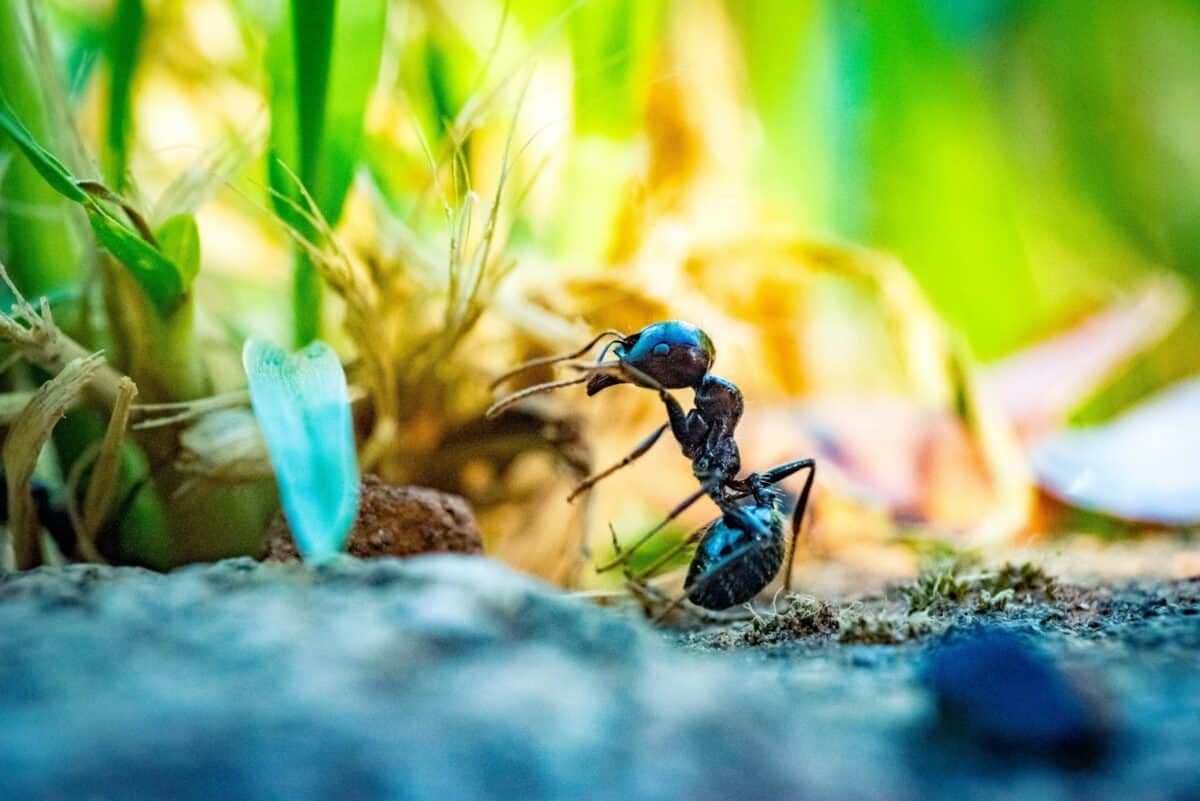Deep in the humid rainforests of South America, Africa, and Asia, a remarkable biological horror story unfolds daily. Unsuspecting ants go about their normal routines until they encounter microscopic spores of a parasitic fungus from the Ophiocordyceps genus. Once infected, these ants transform into what scientists colloquially call “zombies” – their bodies hijacked and their behaviors manipulated to serve the fungus’s reproductive cycle. This mind-controlling fungus, primarily Ophiocordyceps unilateralis, has fascinated scientists and the public alike, offering insights into the complex and sometimes terrifying relationships between parasites and their hosts. The phenomenon represents one of nature’s most dramatic examples of behavioral manipulation and raises profound questions about free will, consciousness, and the evolutionary arms race between species.
The Discovery of Zombie Ant Fungus
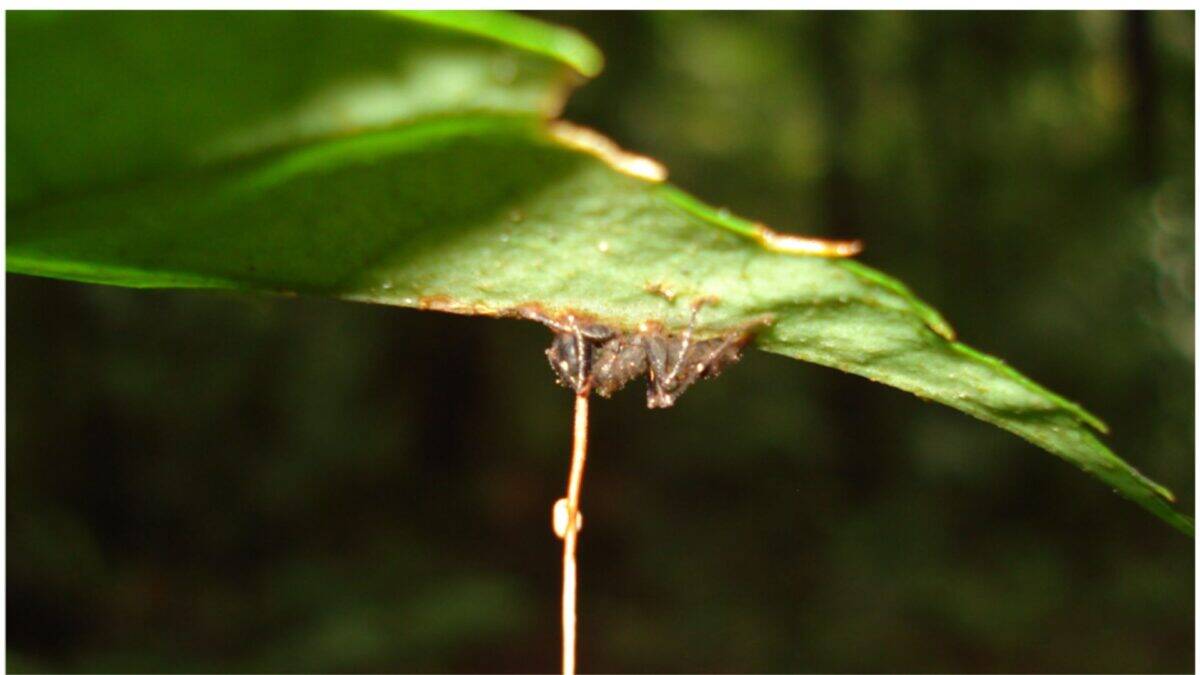
The zombie ant fungus was first scientifically documented in 1859 by British naturalist Alfred Russel Wallace, who observed strange fungal growths protruding from dead ants in the jungles of Indonesia. However, the complete understanding of the fungus’s life cycle and its mind-controlling abilities wasn’t fully comprehended until the early 21st century. In 2010, researchers David Hughes and Harry Evans published groundbreaking studies that detailed the precise mechanisms by which the fungus manipulates ant behavior. Their work catapulted this peculiar parasite into scientific prominence and public consciousness, revealing one of nature’s most sophisticated examples of parasitic mind control. Today, scientists have identified more than 400 different species of Ophiocordyceps fungi, many of which specialize in controlling specific insect hosts, though the ant-controlling varieties remain the most studied and well-known.
How Infection Begins
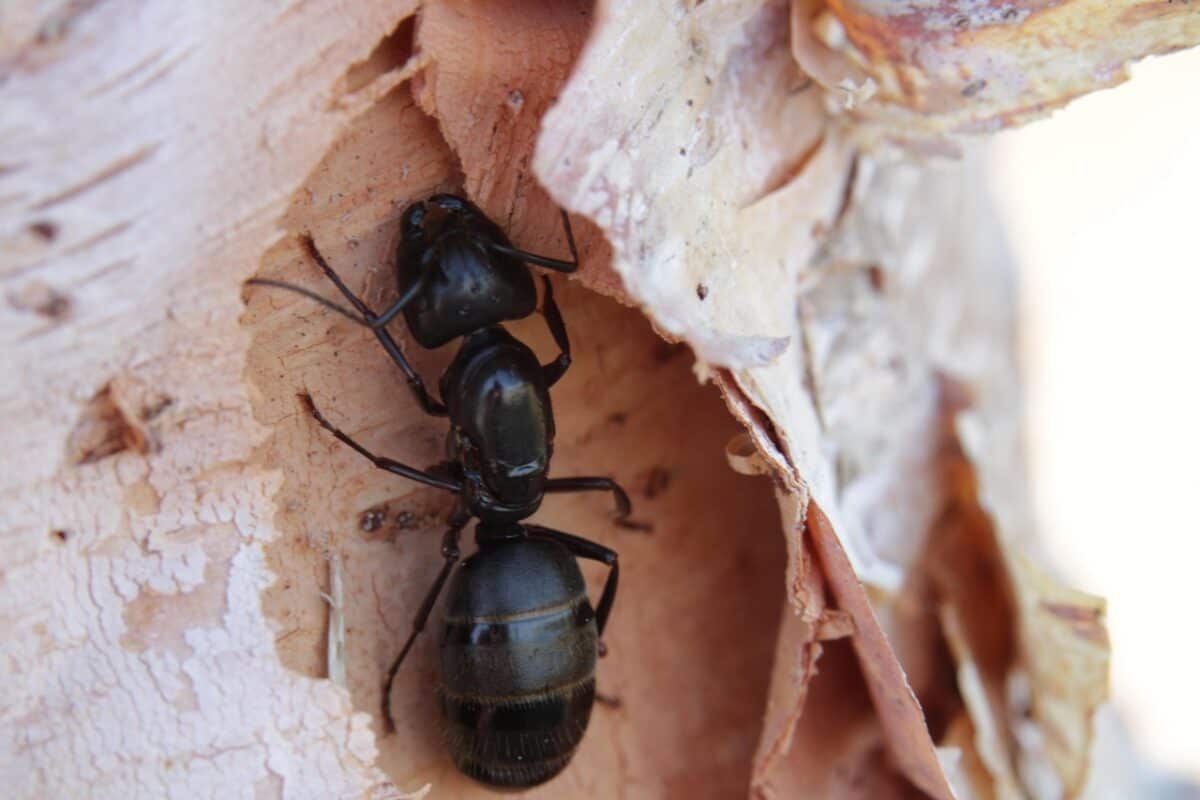
The infection process begins innocuously enough when an ant encounters Ophiocordyceps spores in its environment. These microscopic spores attach to the ant’s exoskeleton and use mechanical pressure and enzymes to penetrate through the tough exterior. Once inside the ant’s body, the fungus begins a remarkable transformation process. It produces thread-like hyphae that gradually spread throughout the ant’s tissues and eventually reach the brain. The fungus doesn’t immediately kill its host – quite the opposite. It keeps the ant alive while slowly taking control of its nervous system. This initial infection phase can last for several days to weeks, during which the ant may continue its normal activities, completely unaware of the invader gradually seizing control of its body. The fungus essentially becomes intertwined with the ant’s internal systems, creating a complex network that allows it to influence the host’s behavior while maintaining its vital functions.
The Death Grip: The Final Manipulation
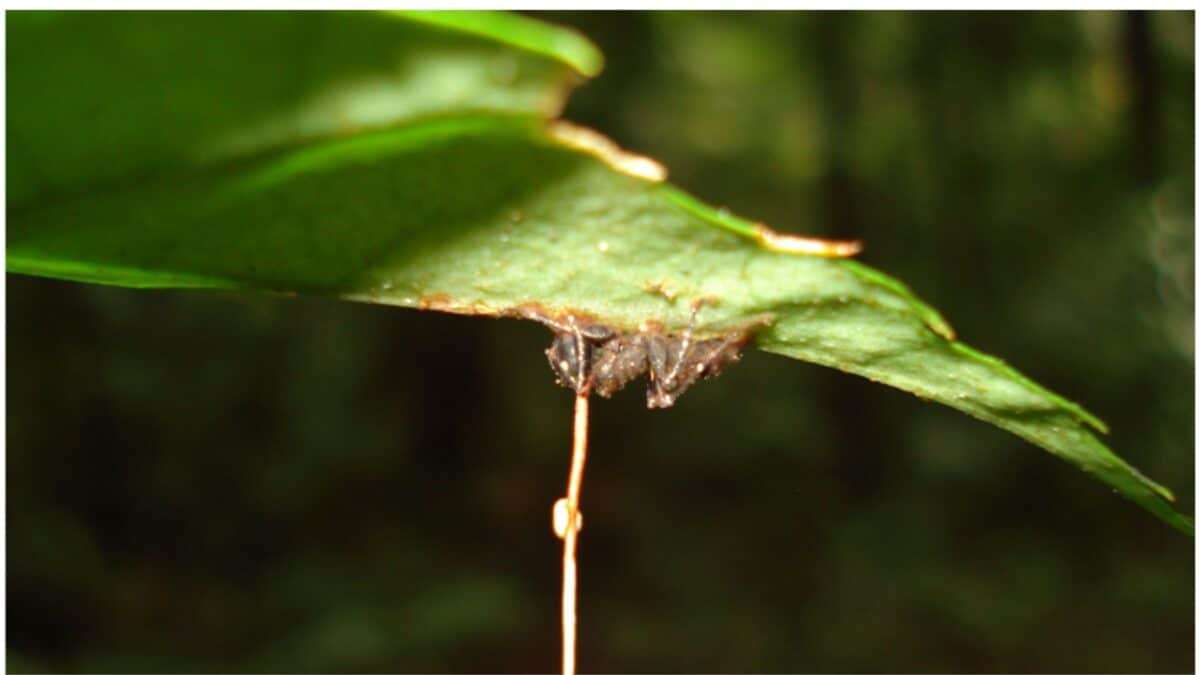
Perhaps the most dramatic and well-known aspect of the zombie ant phenomenon is what researchers call the “death grip.” Once the fungus has sufficiently infiltrated the ant’s nervous system, it compels the insect to leave its colony and climb vegetation – typically a leaf, twig, or stem – to a specific height that offers optimal temperature and humidity conditions for fungal growth. Upon reaching this location, the infected ant bites down on the plant with its mandibles with such force that its jaw muscles atrophy and lock in place, permanently anchoring the ant to the vegetation. This incredible manipulation occurs at a remarkably consistent height of approximately 25 centimeters above the forest floor, regardless of the ant species or location, suggesting sophisticated environmental sensing capabilities by the fungus. The death grip typically occurs around solar noon, and researchers believe this timing maximizes spore dispersal due to midday humidity and air current patterns. This final act ensures the ant remains firmly attached to its perch even after death, positioning the fungus perfectly for its next phase of development.
Biological Mechanisms Behind Mind Control
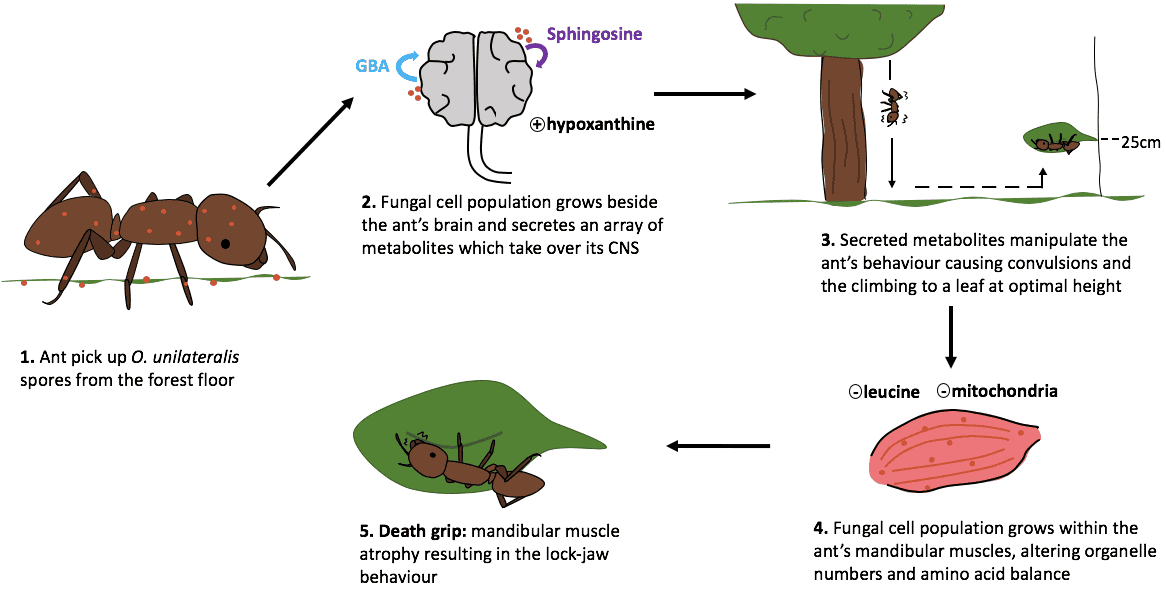
The mechanisms by which Ophiocordyceps controls ant behavior represent some of the most sophisticated examples of parasitic manipulation in nature. Rather than directly attacking the brain cells, the fungus surrounds them with a complex network of hyphae that releases chemicals interfering with the ant’s neurotransmitter systems. Research by Dr. David Hughes and colleagues revealed that the fungus doesn’t actually penetrate the ant’s brain but instead forms a complex network surrounding it, essentially creating an “extended phenotype” that influences neural function without destroying it. The fungus produces compounds similar to those naturally found in the ant’s nervous system, allowing it to effectively “hijack” normal signaling pathways. Recent studies have identified certain fungal secretions that specifically target the ant’s mandibular muscles, explaining the powerful death grip behavior. Molecular analyses have also shown that different genes activate in the fungus during various stages of the manipulation process, suggesting a precisely orchestrated sequence of chemical signals rather than a simple toxic effect. This sophisticated control system represents millions of years of co-evolutionary development between the fungus and its ant hosts.
The Fungal Life Cycle Continues

After the ant has been secured in its death grip, the fungus begins its reproductive phase in earnest. Within 24-48 hours of the ant’s death, fungal hyphae continue to consume the ant’s internal tissues while a stalk (stroma) begins to grow from the back of the ant’s head. This stalk can reach lengths of 3-10 centimeters depending on the fungal species and will eventually develop a capsule filled with spores at its tip. The entire process from infection to spore production typically takes 4-10 days. When mature, this capsule ruptures and releases thousands of microscopic spores that rain down on the forest floor below, creating a “killing zone” where new ants may become infected. The strategic positioning of the dead ant ensures optimal dispersal of these spores. One infected ant can release millions of spores over several weeks, and these spores remain viable for months under the right conditions. This efficient reproductive strategy explains why zombie ants are often found clustered in certain areas of the forest, creating what scientists grimly refer to as “ant graveyards.”
Species Specificity and Evolution
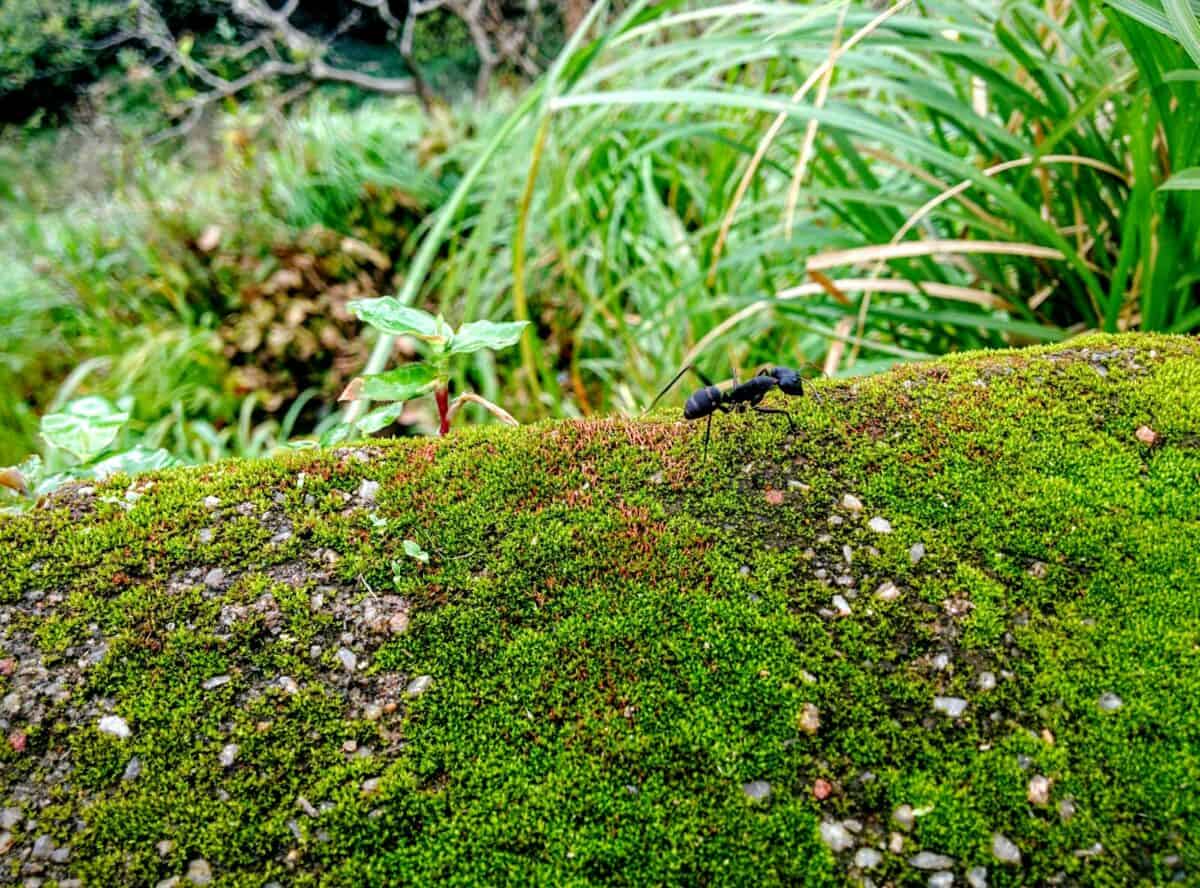
One of the most fascinating aspects of the zombie ant fungus is its remarkable host specificity. Different Ophiocordyceps species have evolved to target specific ant species, with each fungal variant finely tuned to the biology and behavior of its particular host. For example, Ophiocordyceps unilateralis sensu lato specializes in carpenter ants of the Camponotus genus, while other variants target different ant species. This specialization suggests a long co-evolutionary history between parasite and host, estimated to span at least 48 million years. The evolutionary arms race has led to astonishing adaptations on both sides. Some ant species have developed behavioral defenses, such as recognizing and removing infected individuals from the colony or avoiding areas with high concentrations of fungal spores. Meanwhile, the fungi have evolved increasingly sophisticated methods of manipulation and immune suppression. Genetic studies indicate that the fungi are evolving more rapidly than their hosts, suggesting they currently have the upper hand in this evolutionary battle. This species-specific relationship is so precise that researchers can often identify the ant species simply by examining the growth pattern and characteristics of the fungus protruding from its body.
Colony-Level Impacts and Defenses
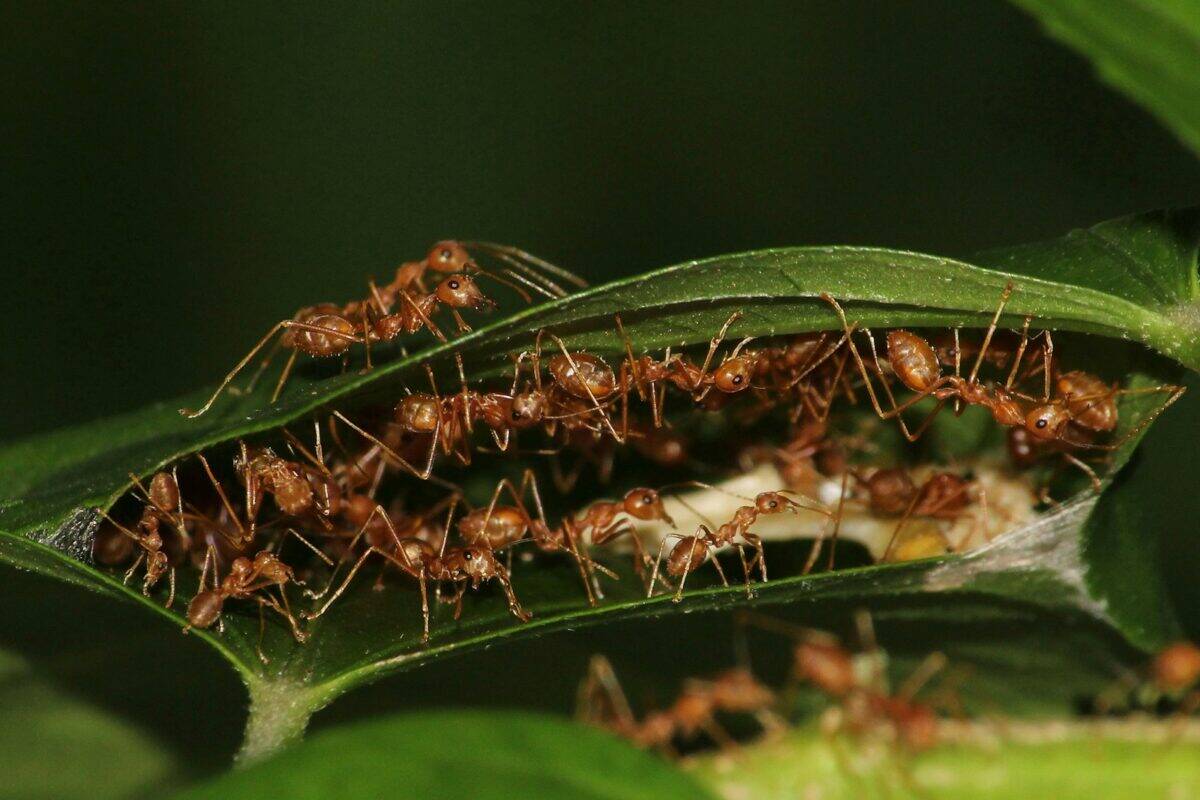
The impact of Ophiocordyceps infections extends beyond individual ants to affect entire colonies. Research indicates that infection rates in tropical forests can reach up to 6.5% of ant populations, representing a significant mortality factor. Ant colonies have evolved several defensive strategies against the fungal threat. Healthy workers may physically carry infected nestmates far from the colony before symptoms become apparent, a behavior called “social immunity.” Some species exhibit increased grooming behaviors that may remove spores before they can penetrate the exoskeleton. Perhaps most remarkably, certain ant species have been observed to establish their colonies in areas with environmental conditions unfavorable to fungal growth. Studies in Thailand have documented entire ant colonies relocating to different elevations or microhabitats after experiencing Ophiocordyceps outbreaks. The fungus, in turn, continues to evolve strategies to overcome these defenses, including faster-acting strains that can complete their manipulation before the colony detects the infected individual. This constant evolutionary pressure may partially explain why some ant species have developed such complex social structures and communication systems – as defense mechanisms against sophisticated parasites like Ophiocordyceps.
Geographical Distribution and Habitat
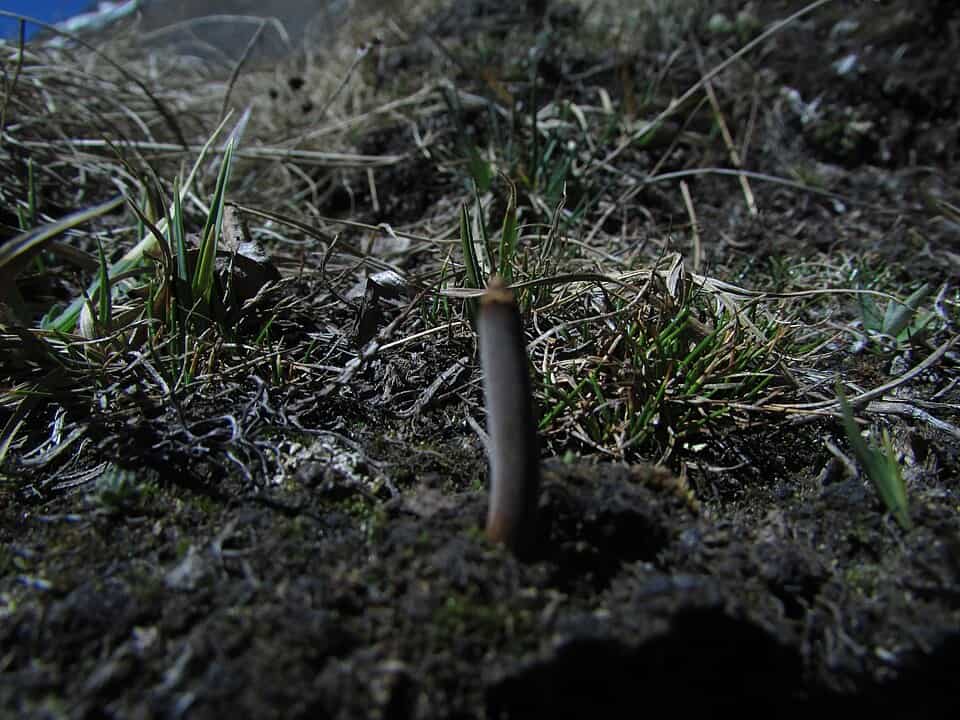
The zombie ant phenomenon is primarily observed in tropical and subtropical forests around the world, with the highest diversity and infection rates occurring in rainforest ecosystems. Different Ophiocordyceps species are found across South and Central America, Africa, Australia, and throughout Southeast Asia. The fungus requires specific environmental conditions to thrive, including high humidity, stable temperatures between 20-30°C (68-86°F), and dense vegetation that provides suitable attachment points for infected ants. Research indicates that climate change may be altering the geographical range of these fungi, with some species expanding into new territories as warming temperatures create suitable conditions in previously inhospitable areas. Interestingly, infection patterns often follow seasonal cycles, with higher infection rates typically occurring during rainy seasons when humidity levels support fungal growth and spore dispersal. Scientists studying forest ecology now recognize Ophiocordyceps fungi as important components of healthy forest ecosystems, as they help regulate ant populations that might otherwise reach levels that could damage forest vegetation. The highest diversity of zombie ant fungi has been documented in the Brazilian Amazon and the forests of Thailand, where researchers continue to discover new species with unique host relationships and behavioral manipulation strategies.
Medicinal and Scientific Applications

Beyond their ecological fascination, Ophiocordyceps fungi have attracted significant attention from medical researchers and pharmaceutical companies. These fungi produce a complex array of bioactive compounds that enable them to suppress insect immune systems, manipulate behavior, and survive within host tissues. Many of these compounds have potential applications in human medicine. For example, cordycepin, a nucleoside analogue isolated from Ophiocordyceps species, has demonstrated anti-cancer, anti-inflammatory, and anti-viral properties in laboratory studies. Other compounds from these fungi are being investigated for potential use in treating immunological disorders, bacterial infections, and even neurodegenerative diseases. The fungi’s ability to precisely control insect behavior has also inspired neurological research, providing insights into the chemical basis of behavior that might eventually inform treatments for human conditions affecting motor control or cognitive function. Biotechnology companies are investigating the potential of engineered Ophiocordyceps compounds as highly specific biological pesticides that could target agricultural pests while sparing beneficial insects. Additionally, the study of how these fungi overcome insect immune defenses may offer valuable lessons for human immunology and contribute to the development of novel antibiotics to address growing concerns about antimicrobial resistance.
Cultural Impact and Popular Representations

The zombie ant fungus has captivated public imagination and permeated popular culture in numerous ways. The 2013 video game “The Last of Us” features a fictional pandemic caused by a mutated Cordyceps fungus that transforms humans into zombie-like creatures, drawing direct inspiration from the real-world ant phenomenon. This representation helped introduce millions to the concept of fungal mind control, albeit in a highly fictionalized form. Similarly, the fungus has featured prominently in nature documentaries, including BBC’s “Planet Earth” series and David Attenborough’s “The Secret Life of Plants,” bringing this remarkable natural process to global audiences. The scientific story has also inspired numerous works of fiction, from horror novels to science fiction tales exploring themes of mind control and biological manipulation. Some indigenous cultures in regions where the fungus occurs naturally have incorporated it into traditional folklore and medicine, recognizing its unique properties long before Western science documented them. The cultural fascination with the zombie ant fungus reflects broader human anxieties about mind control, bodily autonomy, and the hidden forces of nature, making it a powerful metaphor that continues to resonate across various media and artistic expressions.
Related Mind-Controlling Parasites
While Ophiocordyceps is perhaps the most dramatic example of parasitic mind control, it is far from the only one in nature. Numerous other organisms have evolved similar capabilities to manipulate host behavior. Toxoplasma gondii, a protozoan parasite that can infect most warm-blooded animals, famously alters the behavior of infected rodents, making them attracted to cat urine rather than fearful of it – increasing the likelihood of the rodent being eaten by a cat, the parasite’s definitive host. The lancet liver fluke (Dicrocoelium dendriticum) forces infected ants to climb to the tops of grass blades and clamp down with their mandibles during the evening, making them more likely to be consumed by grazing mammals, where the parasite continues its life cycle. Various parasitic wasps inject eggs along with behavior-modifying chemicals into their hosts, turning caterpillars and cockroaches into living food sources for their developing young. Even certain viruses, like the baculovirus that infects gypsy moth caterpillars, can induce “tree-top disease” where infected caterpillars climb to elevated positions before dying, maximizing viral dispersal. These diverse examples demonstrate that mind control has evolved independently multiple times across different branches of life, highlighting its effectiveness as a survival strategy for parasites and raising fascinating questions about the nature of behavior and free will in all organisms.
Recent Scientific Breakthroughs
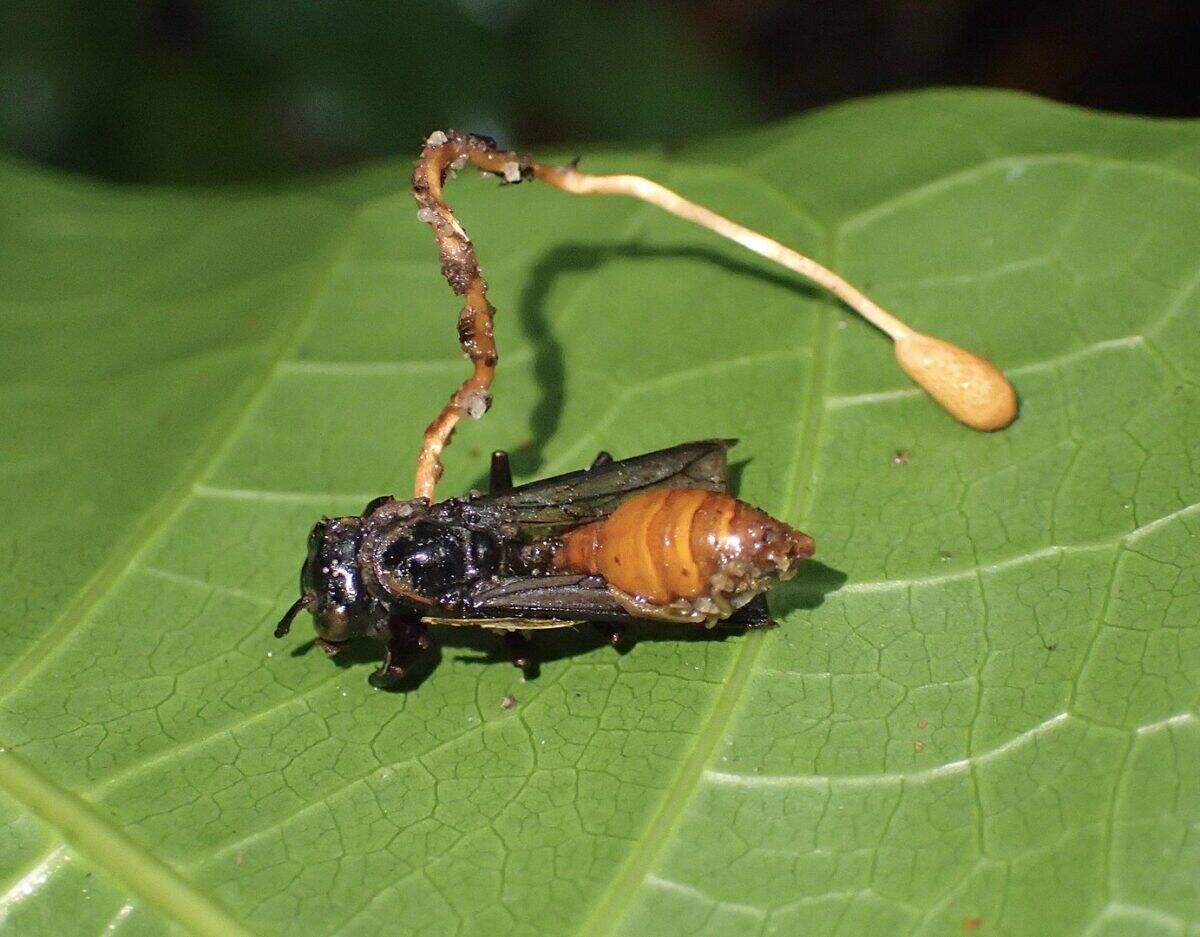
Research on the zombie ant fungus continues to yield fascinating discoveries. In 2017, a team led by Dr. Charissa de Bekker published a groundbreaking study that identified specific fungal genes that activate during different stages of host manipulation. Using advanced genomic techniques, they demonstrated that the fungus produces different compounds for different ant species, confirming the highly specialized nature of the parasite-host relationship. In 2019, researchers successfully cultivated several Ophiocordyceps species in laboratory settings without their ant hosts for the first time, opening new avenues for studying the bioactive compounds they produce. A 2020 study using micro-CT scanning revealed the extensive three-dimensional network that the fungus creates inside the ant’s body, showing how it strategically positions itself around but not inside the brain. Most recently, in 2022, scientists identified specific fungal metabolites that appear to directly interact with the ant’s dopamine system, providing the first concrete evidence of how the fungus might chemically influence ant behavior at the neurotransmitter level. These advances reflect the growing scientific interest in these fungi, driven both by ecological curiosity and by the potential applications of their unique biological mechanisms in medicine, agriculture, and biotechnology. As research tools become more sophisticated, our understanding of this remarkable parasite continues to deepen, revealing ever more complex layers to what may be nature’s most sophisticated mind control system.
The zombie ant fungus represents one of nature’s most extraordinary examples of parasitic manipulation, showcasing the incredible adaptability and ingenuity that can emerge through millions of years of evolutionary pressure. Through its sophisticated chemical arsenal and precise behavioral control, Ophiocordyceps has developed an almost perfect system for reproduction at the expense of its ant hosts. This phenomenon challenges our understanding of biological autonomy and raises profound questions about the nature of behavior itself – if an ant’s actions can be so completely hijacked by a fungus, what does this tell us about the biological basis of behavior in all organisms? Beyond philosophical considerations, the practical applications of studying these fungi continue to expand, from potential new pharmaceutical compounds to insights into neuroscience and immune function. As climate change alters ecosystems worldwide, monitoring these specialized parasitic relationships may also provide valuable indicators of ecological health and adaptation. The story of the zombie ant fungus reminds us that even in the age of advanced technology and exploration, some of the most alien and fascinating phenomena on our planet can be found in the complex interactions between seemingly simple organisms in the forests around us.
- America’s Most Endangered Mammals And How to Help - August 9, 2025
- The Coldest Town in America—And How People Survive There - August 9, 2025
- How Some Birds “Steal” Parenting Duties From Others - August 9, 2025

